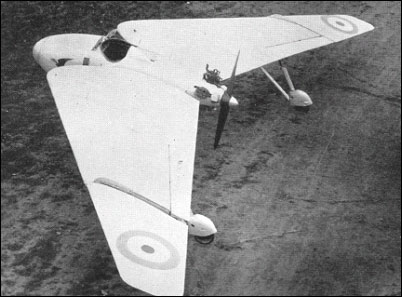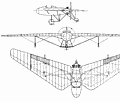 |
Westland Pterodactyl Mk IA, IB1925 |  |
| TAILLESS "PUSHER" MONOPLAN | Virtual Aircraft Museum / United Kingdom / Westland |
 |
In the early 1920's Captain (now Professor) G. T. R. Hill began a study of aeroplane design, with the object of discovering a means of securing safety in flight. This was to be achieved by improving stability and control at low speeds, and even below stalling speed, so that the fatal spin, all too common in those days, would never occur. Captain Hill's investigations eventually led him to evolve a tailless form of aircraft in which the wings were arranged roughly in the form of a blunt arrow-head and, with Mrs. Hill's assistance, he built a prototype as a glider, naming it after that pre-historic reptile the Pterodactyl, in view of its wing-tip control. Successful tests on the South Downs demonstrated to the Air Ministry the practicability of the design, and they, in view of its possible military advantages, co-operated with Captain Hill to fit the machine with a small 34hp Bristol Cherub engine. The first power flight of the Pterodactyl took place at the Royal Aircraft Establishment, Farnborough, and, after final demonstrations before Sir Samuel Hoare, then Secretary of State for Air, the Westland Works took over the development of the type, Captain Hill joining the staff for this purpose. The first Westland-Hill production was a side-by-side two-seater, with wings differing in plan-form considerably from those of the original machine. It was designated the Mk. IA when fitted with a 34hp Bristol Cherub engine, but after this engine was replaced by a 70hp Armstrong Siddeley Genet, and small rudders were fitted, it was given the mark number IB. The design was important, since it successfully demonstrated that a wing loading far greater than that of the prototype did not affect the solutions of stability and control evolved by Captain Hill. Originally flown by Flt.-Lt. L. G. Paget, A.F.C., and with Flt.-Lt. F. J. Brunton carrying out some of the later work, this Pterodactyl was used for a great number of investigations and, as a result, it was possible to proceed with complete confidence to other designs, of which the Pterodactyl Mk. IV was the next to be built. A.H.Lukins "The Book of Westland Aircraft", 1943
|  COMPANY PROFILE | ||||||||||||||||||||||||||||||||||||||||
 |

|


